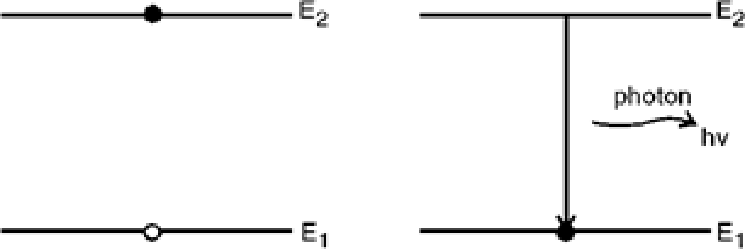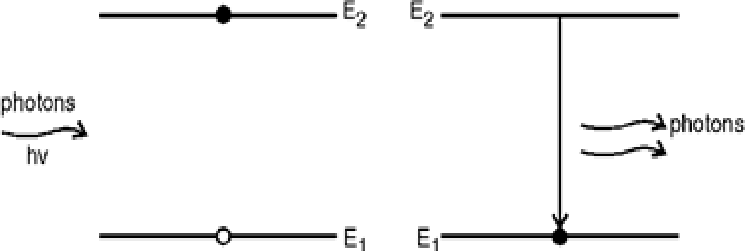Einstein Coefficient Relation
Einstein Coefficient Relation derivation and discussion:
Einstein showed the interaction of radiation with the matter with the help of three processes called stimulated absorption, spontaneous emission, and stimulated emission. He showed in 1917 that for a proper description of radiation with matter, the process of stimulated emission is essential. Let us first derive the Einstein coefficient relation on the basis of the above theory:
Let N1 be the number of atoms per unit volume in the ground state E1 and these atoms exist in the radiation field of photons of energy E2-E1 =h v such that the energy density of the field is E.
Einstein Coefficient for Stimulated Absorption:
Let R1 be the rate of absorption of light by E1 -> E2 transitions by the process called stimulated absorption (Refer below figure):

This rate of absorption R1 is proportional to the number of atoms N1 per unit volume in the ground state and proportional to the energy density E of radiations.
That is R1∞ N1 E
Or R1 = B12N1 E (1)
Where B12 is known as the Einstein’s coefficient of stimulated absorption and it represents the probability of absorption of radiation. Energy density e is defined as the incident energy on an atom as per unit volume in a state.
Einstein Coefficient for Spontaneous Emission:
Now atoms in the higher energy level E2 can fall to the ground state E1 automatically after 10-8 sec by the process called spontaneous emission (Refer below figure).

The rate R2 of spontaneous emission E2-> E1 is independent of energy density E of the radiation field.
R2 is proportional to number of atoms N2 in the excited state E2 thus
R2∞ N2
R2=A21 N2 (2)
Where A21 is known as Einstein’s coefficient for spontaneous emission and it represents the probability of spontaneous emission.
Einstein Coefficient for Stimulated Emission:
Atoms can also fall back to the ground state E1 under the influence of the electromagnetic field of an incident photon of energy E2-E1 =hv by the process called stimulated emission (Refer below Figure):

Rate R3 for stimulated emission E2-> E1 is proportional to energy density E of the radiation field and proportional to the number of atoms N2 in the excited state,thus
R3α N2 E
Or R3=B21N2 E (3)
Where B21 is known as the Einstein coefficient for stimulated emission and it represents the probability of stimulated emission.
Einstein Coefficient Relation Derivation:
In steady-state (at thermal equilibrium), the two emission rates (spontaneous and stimulated) must balance the rate of absorption.
Thus R1=R2+R3
Using equations (1,2, and 3) ,we get
N1B12E=N2A21+N2B21E
Or N1B12E –N2B21E=N2A21
Or (N1B12-N2B21) E =N2A21
Or E= N2A21/N1B12-N2B21
= N2A21/N2B21[N1B12/N2B21 -1]
[by taking out common N2B21from the denominator]
Or E=A21/B21 {1/N1/N2(B12/B21-1)) (4)
Einstein proved thermodynamically, that the probability of stimulated absorption is equal to the probability of stimulated emission. thus
B12=B21
Then equation(4) becomes
E=A21/B21(1/N1/N2-1) (5)
From Boltzman’s distribution law, the ratio of populations of two levels at temperature T is expressed as
N1/N2=e(E2–E1)/KT
N1/N2=ehv/KT
Where K is the Boltzman’s constant and h is Planck’s constant.
Substituting value of N1/N2in equation (5) we get
E= A21/B21(1/ehv/KT-1) (6)
Now according to Planck’s radiation law, the energy density of the black body radiation of frequency v at temperature T is given as
E = 8πhv3/c3(1/ehv/KT) (7)
By comparing equations (6 and 7),we get
A21/B21=8πhv3/c3
This is the relation between Einstein’s coefficients in laser.
Significance of Einstein coefficient relation: This shows that the ratio of Einstein’s coefficient of spontaneous emission to the Einstein’s coefficient of stimulated absorption is proportional to the cube of frequency v. It means that at thermal equilibrium, the probability of spontaneous emission increases rapidly with the energy difference between two states. If you want to learn derivation of Einstein Coefficient relations, then following is our youtube video also:
How does probability of absorption is reduced compared to stimulated emission?
In LASERs, do trigger photons used in continuous mode?
for a two level energy system it is impossible to have a LASER. The enegy levels have to be 3or 4 or above to have a population invertion thus we can have a greater stimulated emmision than absorbsion.
Thank u for this ans. it’s very helpful for me.
You made a mistake in elaborating the significance.
Its must be corrected to, the ratio of Einstein coefficient of spontanious emission to Einstein coefficient of stimulated emission.
Please check again